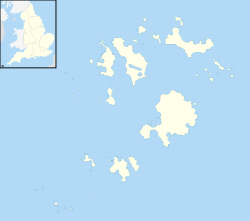White Island, Isles of Scilly facts for kids
|
Ar Nor
|
|
|---|---|

White Island viewed from St Martin's
|
|
| Geography | |
| Coordinates | 49°58′45″N 6°17′32″W / 49.979071°N 6.292114°W |
| OS grid reference | SV924176 |
| Archipelago | Isles of Scilly |
| Area | 0.059 sq mi (0.15 km2) |
| Administration | |
|
United Kingdom
|
|
| Civil parish | St Martin's |
| Demographics | |
| Population | 0 |
White Island (which means "facing the mainland" or "white island" in Cornish) is one of the larger islands in the Isles of Scilly that no one lives on. It's part of the United Kingdom. This island is located off the coast of St Martin's, which is the northernmost island where people live in the group.
White Island is connected to St Martin's by a natural path called a tidal causeway or isthmus. This path appears at low tide. The island is very special and is protected as a Site of Special Scientific Interest (SSSI). This means it has important plants, animals, or geology. It's also a Geological Conservation Review site, which highlights its important rocks and landforms. The Isles of Scilly Wildlife Trust looks after the island for the Duchy of Cornwall.
It can be risky to cross to White Island when the rocky path is covered by the sea. There are strong currents that flow across it. It's good to know that this White Island is not the same as a much smaller island with the same name near Samson.
Island History
This island, where no one lives, is found off the north coast of St Martin's. It covers about 15.25 hectares (which is about 37.7 acres). Not too long ago, it was actually part of St Martin's. In 1814, people thought the island was about 50 acres big.
At the north-east end of the island, you could see a piece of changed rock called killas in 1911. This type of rock used to cover a much larger area.
Most of the place names on White Island are English, just like on the bigger island. But there are a couple of Cornish names. "Camper" on the south-east coast means "tide race" or "roost" in Cornish. "Porthmoren" is a place on the west side of the shingle and boulder bar that separates the two islands. In Cornish, "moren" means "girl" or "maiden," and "porth" means "landing place."
The north-west part of the island rises to 21 meters (about 69 feet) high. At the top, there are the remains of an entrance grave. This is an ancient burial place. There are also other old monuments, like a chambered cairn (a stone mound with a room inside) and several other cairns (piles of stones). To the south, protected by the hill, are six small mounds or cairns.
You can also see two walls that show an old field system with a bank and ditch. In 1975, experts looked at one cairn. It was about 3 meters (10 feet) across and might have had double walls on its north side. It was probably too small to be a hut circle, which is a circular stone foundation of an old house. Only part of White Island is officially protected as an Ancient Monument right now. However, experts think the whole island should be protected.
Nature and Wildlife
White Island is a Site of Special Scientific Interest (SSSI) for several reasons. It has special types of plants like waved maritime heath and maritime grassland. Many seabirds also come here to breed. The island is also important for its layers of Late Pleistocene deposits found in a crack called Chad Girt. This crack almost splits the island in two.
The layers of rock and soil from the Quaternary period (the last 2.6 million years) show a lot about Earth's past:
- A raised beach, which is an old beach now higher than sea level.
- A type of rock called granitic head, also known as Porthloo Breccia. This is named after a place on St Mary's island.
- Gravel that has moved downhill slowly due to freezing and thawing, called Hell Bay Gravel. This gravel contains pieces of rock and fine dust (called loess) from ice age material in the Irish Sea.
- More head rock with large rocks (called erratics) that were carried by glaciers. This is named after a nearby spot on St Martin's (Bread and Cheese Breccia).
Because White Island is on the northern edge of the Isles of Scilly, it gets a lot of strong winds and salt spray from the sea. This means the soil is thin and sandy. It's covered in a type of plant community called wind-blown maritime heath. The main plants here are western gorse, bell heather, and heather. You can also find English stonecrop, bird's-foot trefoil, and heath bedstraw growing among the heath and gorse.
In areas with deeper soil, bracken plants are common. You might also see bramble and honeysuckle. Along the western coast, there's a small area of maritime grassland. Here, you'll find plants typical of the Isles of Scilly, such as red fescue, thrift, common scurvygrass, buck’s-horn plantain, and sea beet.
In April 2001, a very rare type of lichen called gilt-edged lichen was found on White Island. This was the first time it had been officially seen in the Scilly Isles since 1967! This lichen is common in tropical places and in areas like Macaronesia (islands in the Atlantic). However, it's very rare in mainland Europe. It's a special species that needs protection under the UK Biodiversity Action Plan and the Wildlife and Countryside Act 1981.
Breeding Birds
Four types of gulls and one type of petrel bird come to White Island to lay their eggs and raise their young. These birds are:
- Great Black-backed Gull (Larus marinus)
- Lesser Black-backed Gull (Larus fuscus)
- Herring Gull (Larus argentatus)
- Kittiwake (Rissa tridactyla)
- Fulmar (Fulmarus glacialis)


